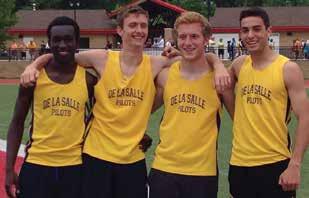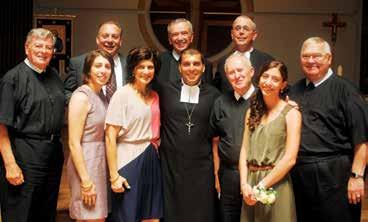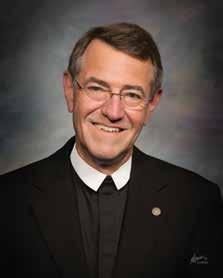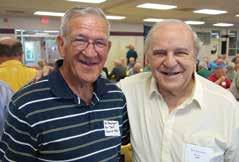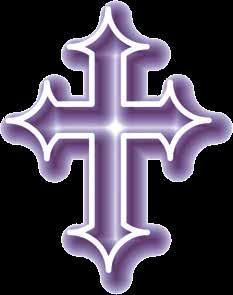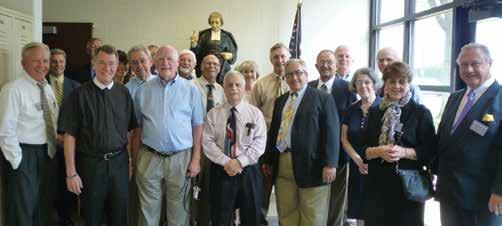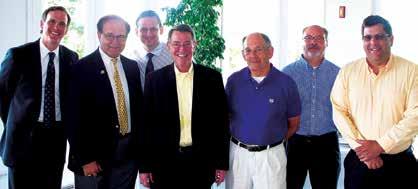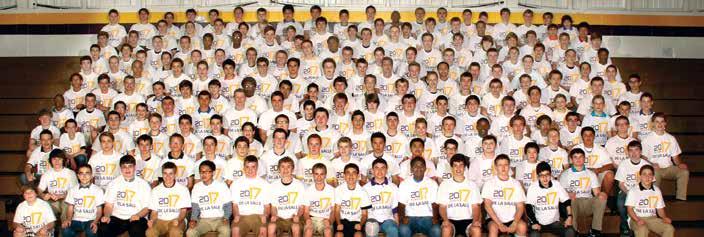
8 minute read
Academic News
Changing the Landscape of Education Innovations in the Spirit of St. John Baptist de La Salle
The Patron Saint of Teachers, St. John Baptist de La Salle, pioneered numerous educational innovations. Nearly 300 years after his death, that same innovative spirit guides the school’s mission. St. John Baptist de La Salle would have been right at home in the classrooms and hallways of De La Salle Collegiate.
Technology as a Tool for Learning
While DLS teachers have incorporated technology into their classroom teaching for more than a decade, from websites to smartboards, the past school year marked the introduction of Chromebooks and the use of “Google Apps” for education. According to DLS Principal Mr. Patrick Adams, there is significant research that frequent and meaningful feedback between students and teachers is how kids learn. “Students are using the Chromebooks to access informational texts, either in the classroom setting or in their unscheduled time in what we call the Digital Resource Center (DRC), formerly ‘the Library.’ Students read and analyze various texts, and prepare documents in the cloud, as a Google document. The students then share those documents, and teachers are able to give each student more frequent feedback.” There are now three classroom sets of Chromebooks used in the Freshmen English classes and in the Freshmen Seminar classes.
Freshmen use the tablets for research, extensive writing practice, and for learning Google Apps. These Chromebooks are in addition to the classroom set available in the DRC for individual checkout or for a full class’s use right in the DRC. Mr. Adams says, “A full class can be in the middle of the DRC, at fourman tables, using the Chromebooks, while another 50 students can be on the perimeter using one of the desktop computers.” “We’re looking to create that feedback loop,” says Mr. Adams. “Our students are comfortable with the digital world, and we’re providing access.” The school plans to have a tablet in every freshman’s hands in the 2014-2015 school year, says Mr. Adams, with the goal of having a tablet computer for all students by the 2017-2018 school year. Mr. Adams says, “We have a clear vision and plan to introduce technology into the curriculum as a tool. Just as we methodically rolled out the Smart Boards, over a two-three year period of time, we are methodically training teachers to incorporate technology into their lessons.” But this is not the “tablet in every locker” philosophy. Mr. Adams says, “One of the many mistakes in implementing One-toOne initiatives is trying to do it all at
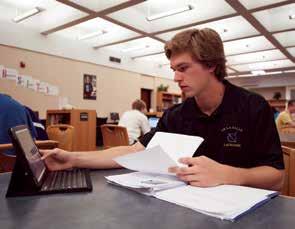
Academic News
one time. It’s not innovative to just put a tablet in the hands of every student and say ‘go learn.’ What IS innovative, in the spirit of St. John Baptist de La Salle, is to develop ways for teachers and students to utilize the tools to learn in a more effective way than they could before.”
Providing a More
De La Salle is also examining research on the eighth semester, the last semester of high school, and developing ways to make that final term a more “college-like” experience. With that eighth semester in mind, the school schedule is no longer a six-day schedule; Mondays will always be Day 1, Fridays will always be Day 5. That schedule change opens up numerous opportunities for seniors, such as online learning, dual enrollment, and co-op job experiences. Online learning begins during the 2013-2014 school year as seniors will be able to take an online religion course through Lewis University, a Lasallian college in Illinois. Assistant Principal Steve Stewart says, “Eventually, once the program is tweaked,
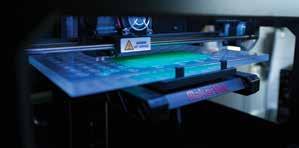
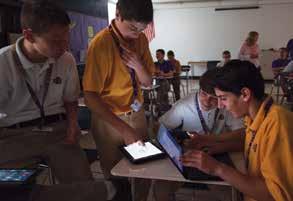
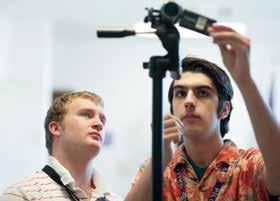
the online option will be available to juniors. You have to crawl, then walk, then run.” DLS has already been in discussions with WSU officials regarding dual enrollment in their new tech facility in the former “Farmer Jack” building at 12 Mile and Gloede. That facility is scheduled to open in 2014. Mr. Adams says that the dual enrollment possibilities will initially be in an engineering track, also called STEM (Science, Technology, Engineering, and Math). Mr. Adams and Mr. Stewart also see Fridays as a chance for students to do community service or go on field trips, as well as the day to meet with teachers for additional help. Mr. Stewart says, “We can customize both ends of the spectrum.”
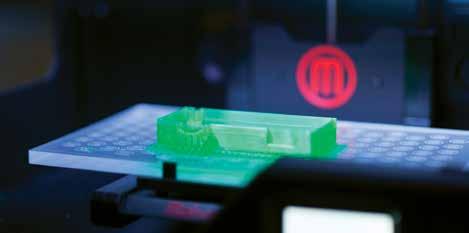
Academic News
Expanding STEM
Perhaps the most significant curriculum innovation at DLS has been in the Engineering program, which earlier generations of Pilots knew as “Mechanical Drawing.” For several years, instructor Mrs. Sharlene Kroneck has utilized Computer Aided Design (CAD) programs in her Introduction to Engineering and Advanced Engineering classes. The Introductory course, first offered in junior year, uses the CATIA Sketcher program, and covers solid and advanced modeling skills. In Advanced Engineering, students learn assembly, drafting, generative surface design, and shapes. Mrs. Kroneck says, “These computer-design courses are extremely popular, giving students an opportunity to discover if they want to be an engineer.” Principal Patrick Adams says that 80% of the students in the Engineering classes go on to pursue Engineering at the college level. The classes took a giant leap forward during the 2012 - 2013 school year, with the upgrade from the CatiaV5 software, which classes had used for five or six years, to the cutting-edge CatiaV6 program. Mrs. Kroneck says that “Kids have a social media mentality. This V6 software harnesses this passion, allowing students from various locations to work simultaneously on the same design. Plus the rich, 3D graphical interface is more intuitive than other solutions.” The Engineering lab has a new 3-D printer, giving students nearly instantaneous feedback on their designs. “Students can see very quickly how successful their work is. Before, I sent the file to a local tool and die company, and students had to wait a few days. Now they wait just a few minutes.” The upgraded software has definite advantages. Mrs. Kroneck said, “The real benefit will come when they set up collaboration, as enabled by V6, with another high school or college class or even industry. This is the way of the future.”
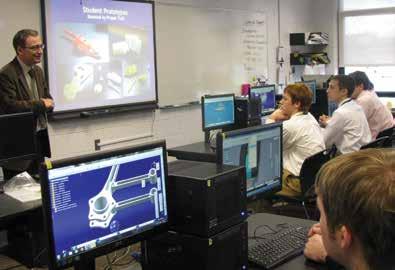
This school year, Mrs. Kroneck is introducing Kinematics to the Advanced Engineering course, as a result of specialized training at the Auburn Hills office of Dassault Systemes. Kinematic analysis, done on the V6 program, is used to see how the internal parts of a mechanism work with each other. While DLS has had a successful Robotics Club for the past six years, Mrs. Kroneck is introducing a new Robotics course this year. She spent part of the summer training at the Robotics Academy offered at Carnegie-Mellon University in Pittsburgh. The 2013-2014 school year sees a continued expansion of computer technology in the Art Department as well. The former darkroom is now a digital video studio. Students are learning the state of the art Adobe After Effects program on Mac computers in classes taught by Mrs. Kroneck and Mr. Bill Littlejohn. The role of computer systems as a learning tool has also expanded in the Academic Support Services at De La Salle, aiding students in Br. Bob Carnaghi’s FAST program for Freshmen, in the SAIL room (where subject level teachers and students work with students who need additional help), and in a new Reading Lab to help students raise their grade level reading capacity.
Academic News
Above Left to Right, Sharlene Kroneck, Roy Smolky ‘59, Thierry Collet, Rick Darter, Bro. Tom Lackey, Tony Scicluna ‘74. On the preceeding page, Thierry Collet addresses an Engineering class.
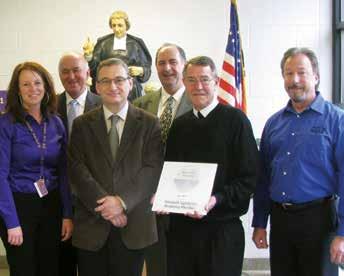
De La Salle Earns Dassault Label
During the 2012-2013 school year, Cameron Sant, ‘16, and Matthew Milobowski, ‘16, participated in the “You Make a Difference” program, sponsored by General Motors at the Tech Center in Warren. The program’s Director is Christos Roustemis, ‘86, lead designer of Cadillac interiors at GM. The two students were nominated by DLS Art Teacher Bill Littlejohn. For 22 weeks, the two Pilots joined several other exceptionally talented students from SE Michigan in two-hour sessions with professional auto designers, creative software experts, and both digital and hands’-on sculptors. Earlier this year, Mr. Thierry Collet, VP for Global Academic Programs and Education at Dassault Systemes, presented De La Salle with the Dassault Systemes Academy Member Label. Dassault is the developer of Catia. The designation recognizes institutions for utilizing the software to improve curriculum quality and student employability. DLS is one of only two high schools in the United States to have earned the prestigious designation. “De La Salle’s classes are designed to encourage every possible interest in STEM topics, which is so important as we face a deficit of engineers in America. We are inspired by the creativity and free thinking that comes with this wave of new engineers,” said Mr. Collet. DLS Alumnus Mr. Roy Smolky, ‘58, also from Dassault, facilitated the acquisition of the V6 software. Locally, Rave Computer provided the server and designed the computers specifically to accomodate CatiaV6. Rick Darter, President of Rave Computer, and Tony Scicluna, ‘74, VP of Sales at Rave, joined the presentation at
Aspiring Auto Designers Mentored in GM Program
De La Salle.
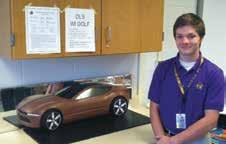
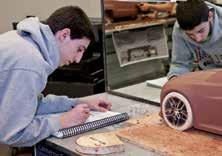
After several weeks of sketching lessons and designing cars using traditional means, students moved on to sketching and surfacing using Photoshop, Alias, and Sketchbook Designer. In January 2013, they began working with GM sculptors to create scale clay models of their designs. The program wrapped up in late April, with a final presentation with 30 unique designs on display. Each aspiring artist presented to an audience of well over 100 in the historical GM Design dome about their design concepts, their experiences in the program, their potential future in design, and the mentors they worked with.


